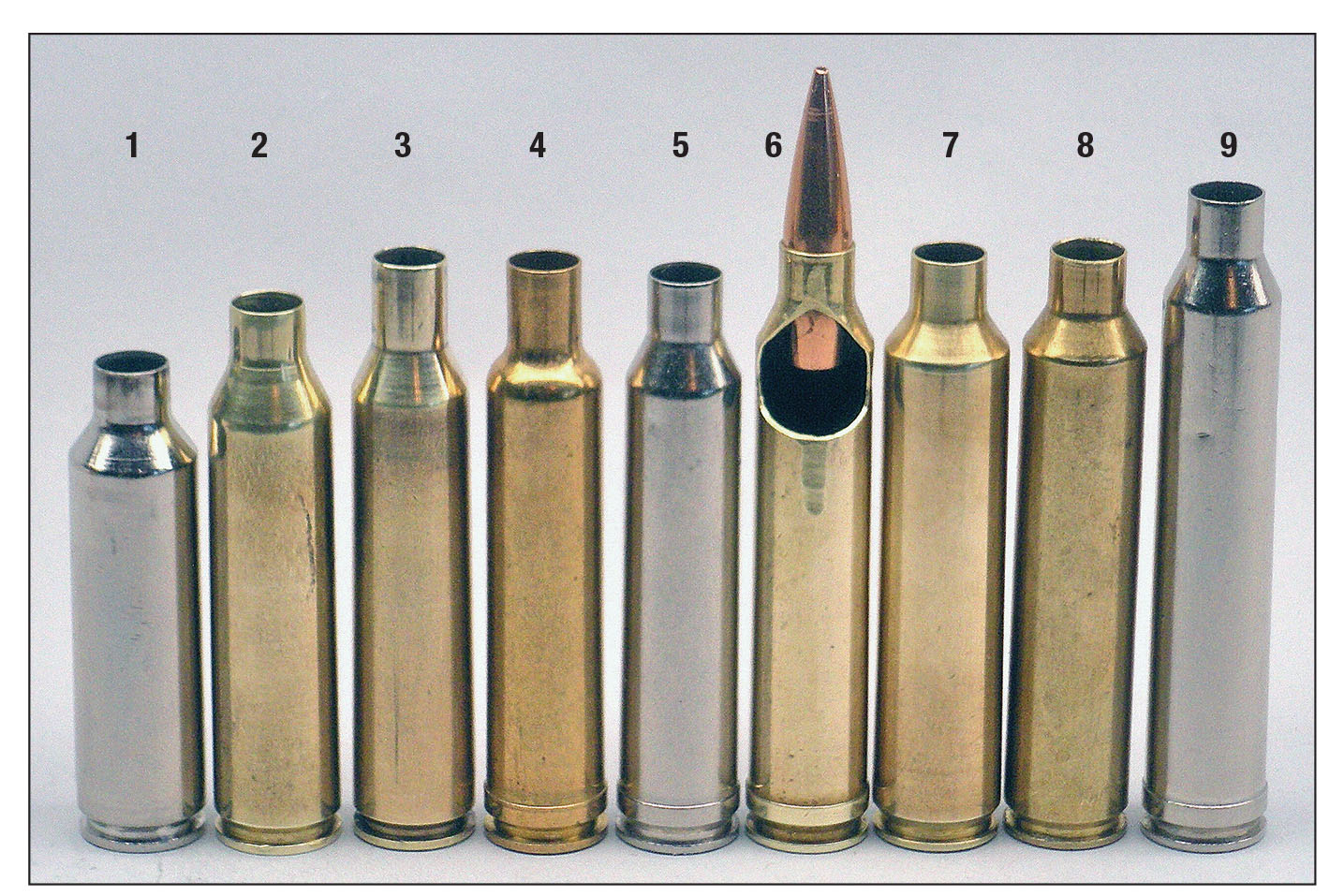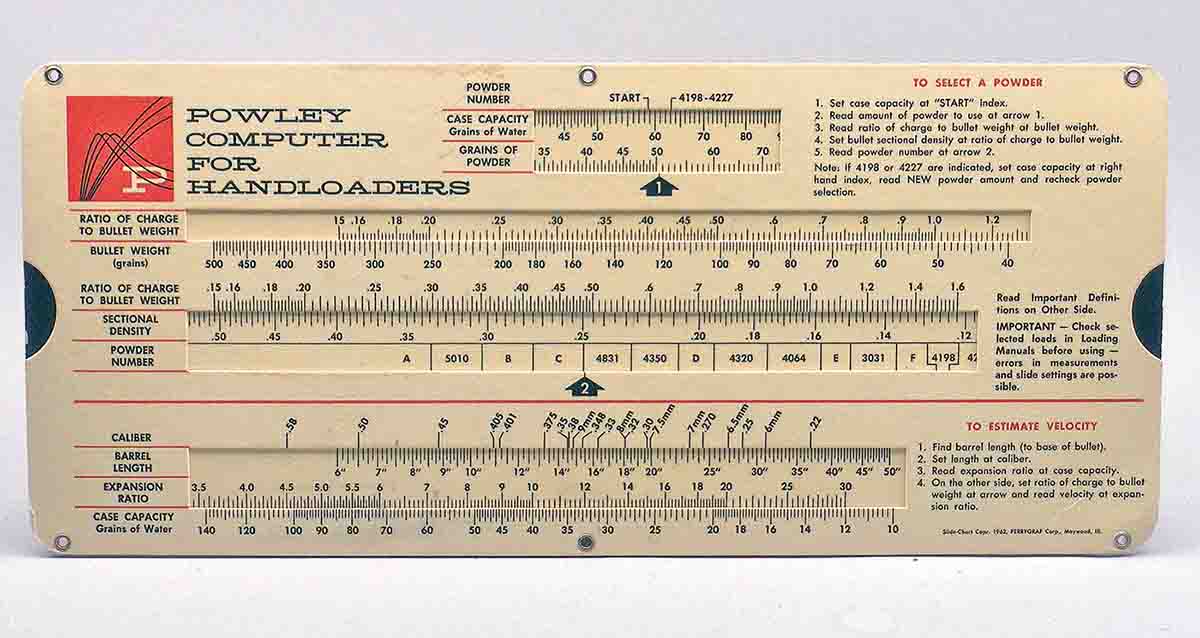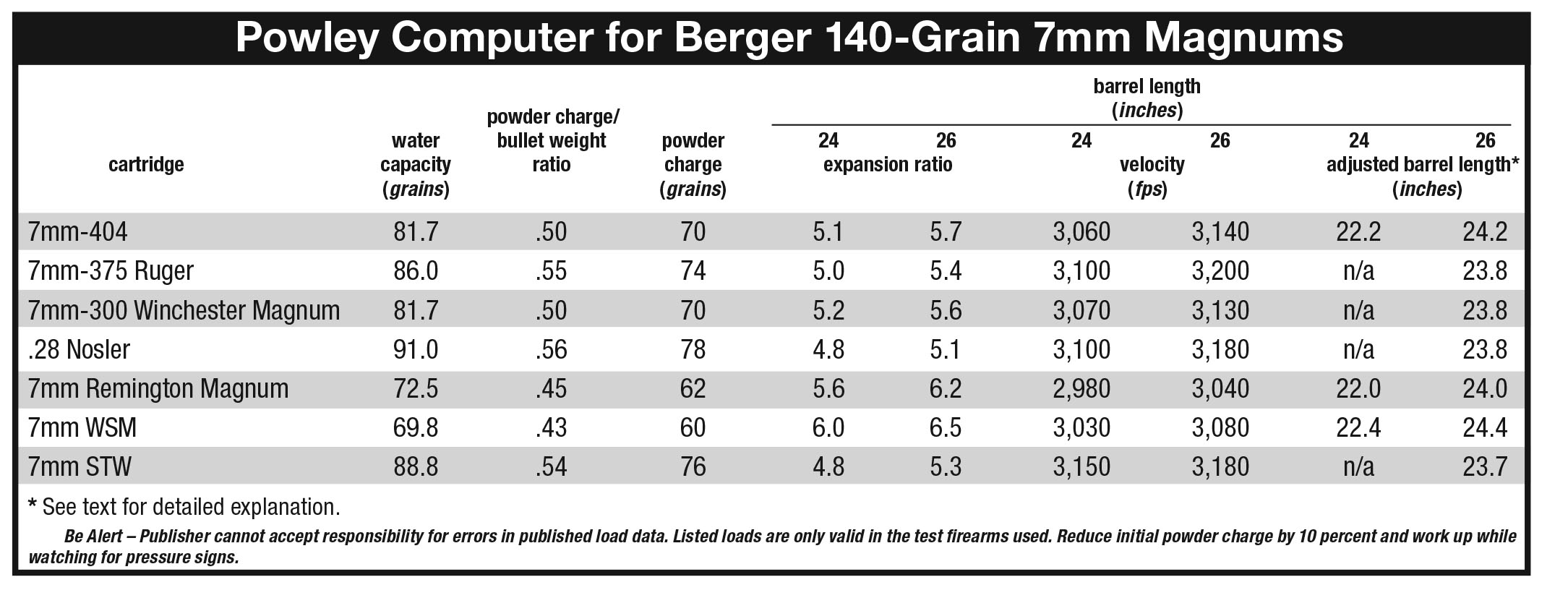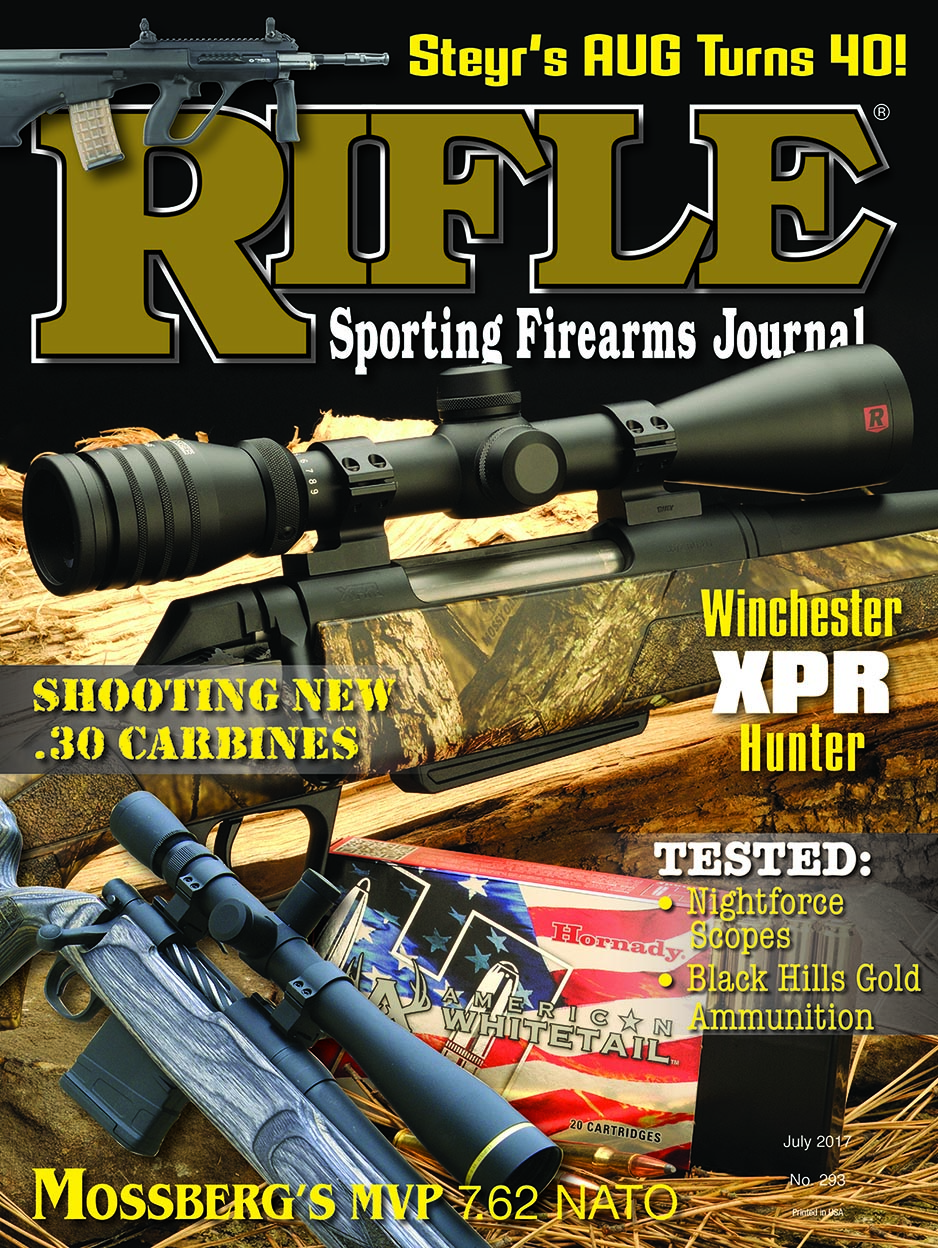Spotting Scope
Cartridge Design
column By: Dave Scovill | July, 17
There has been a lot of chatter on various blogs since the .375 Ruger was introduced awhile back. Most of the chatter is directed at how that case might be necked down to .30, 7mm or 6.5 calibers in an effort to build a super-zapper for big game or long-range target work. Overall, most of the projected assumptions regarding velocity with various bullet weights are overly optimistic – some wildly so.

In response to the interest in wildcatting the .375 Ruger, I decided to neck it down to .30 caliber and see how it compared to some of the claims some folks were making for it. As predicted, with some help from the Powley Computer for Handloaders, a slide-rule device that computes velocity based on basic internal ballistic calculations, results for the .30-375 Ruger fell between the .300 Winchester Magnum and .300 Weatherby Magnum. It’s pure physics, albeit the Powley Computer helps avoid the basic math involved, which requires a working knowledge of calculus. In lieu of the Powley Computer, NECO QuickLoad is a modern computer equivalent. Some claim the format is outdated, but the basic math is valid.
Sometime after building a .30-375 Ruger rifle, Nosler’s cartridges started showing up, which pretty much ended the velocity race in big magnum-type cartridges, especially since the Nosler case has a .528-inch rebated rim and a .547-inch case body, and the Ruger case is based on the almost ancient Newton case – .528 inch at the rim and base, with a slight taper to the shoulder. As a result, the Ruger case has less powder capacity than the Nosler design, assuming both are loaded to 3.34 inches overall loaded length (OAL). For reference, the Gunwerks 7mm LRM is based on a shortened 2.5-inch .375 Ruger case. Also, the 7mm-300 Winchester Magnum was once known as the 7x66 Randle (Horacio Randle) and 7mm Super Magnum (Mashburn); limited loading information is available on Load Data.com and in Wildcat Cartridges (Wolfe Publishing, 1992, but now out of print). The 7mm-404 is somewhat similar to the 7mm Dakota, although the length of the sample used here represents a rough estimate, in terms of length and capacity.
To narrow this down, cartridges listed in the table were selected for evaluation in terms of case capacity and velocity projections. To determine case capacity, the cases were weighed, filled with water and then a Berger 140-grain Hunting/Target bullet was seated to 2.8, 3.34 and 3.6 inches overall length for respective action lengths in case necks that were bumped up from .282-inch inside neck diameter to .286 inch – just enough to allow a slip-fit of the .284-inch bullet by hand to the same depth in all the cases. This allowed the excess water to leak out of the case mouth, so when the bullet was withdrawn, the case and water were weighed, and the weight of the empty case was subtracted to yield total water capacity under the Berger bullet. (Note: Case capacity routinely varies by bullet design and case brand.)
Then the water capacity was used on the Powley Computer to determine the actual powder capacity. For example, 81.7 grains of water computes to 70 grains of powder. For comparison to the tables, the computer assumes an operating pressure of around 50,000 psi, whereas cartridges listed in the tables vary from approximately 53,000 to 63,000 psi. For a rough estimate of velocity at higher pressures, a two percent increase in pressure represents an approximate one percent velocity increase.

The next step was to use the sectional density of a 140-grain bullet (.266) to determine the appropriate powder on the computer. The larger cases require a powder that is, in some designs, not identified by name but by letter, B or C, both of which are slower burning than IMR-4831 and somewhat faster than the old IMR-5010. Converting to the Reloder series of Alliant powders, it can be assumed RL-22, 23 and 25 cover the B to C range, along with applicable powders by Vihtavuori, Hodgdon, Winchester, Western, etc., that are slower than IMR-4831 and faster than IMR-5010 and are listed in various tables of relative burning rates from fastest to slowest. These powders are also listed in loading manuals for respective bullet weights in appropriate cartridges.
Next up was to determine expansion ration (ER), the number of times the gas volume generated by the burning powder expands in the barrel, measuring barrel length from the base of the bullet to the muzzle. To find ER, the computer converts volume in water to cubic inches. Add that number to the volume of the barrel (Pi x radius squared x length in inches) and divide the result by the volume of the case capacity in cubic inches. In effect, seating the bullet deeper reduces the powder capacity (volume) and increases the barrel length, while seating the bullet out farther than an OAL of 3.34 inches, for example, decreases the barrel length.
Using a 24- or 26-inch barrel with the cartridges mentioned above, the measurement between the base of the bullet and the bolt face varies from 2.35 to 1.65 inches, so we subtract that number from barrel length of either 24 or 26 inches to determine the actual barrel length, or the distance the bullet travels to the muzzle, 26 - 2.2 = 23.8 inches. This is the barrel length used to determine the ER for a 7mm barrel and the water capacity of the case under a 140-grain bullet.
The final step on the Powley Computer is to use the ratio of powder charge to bullet weight with appropriate ER to determine velocity. From the table, the 7mm WSM has the highest ER based on the measurement from the bolt face to the base of the bullet, 22.4 or 24.4 inches. This simply means the powder charge does more work than the larger charges used in the bigger, and longer, cases. This has been interpreted by some to mean the short, fat WSM case is more efficient than longer, narrow cartridges, but it really means the bullet is fired from a longer barrel with slightly less powder than its larger counterparts, hence the powder charge does more work as measured by the ER. The WSM case, in itself, does not materially affect the burning rate or the efficiency of the burning powder. For general reference, the powder charge in a typical 2.5-inch cartridge case is totally consumed within two millionths of a second. During that period the bullet has moved to the point of peak pressure, which in most larger cartridges ranges from 4 to 6 inches.
The general trend by experimentally minded folks over the years has been to seat the bullet out farther in some instances, where the magazine length allows, but as can be seen from the table, this has the effect of decreasing the ER and effective barrel length. As a rule, the greater the distance from the base of the bullet to the bolt face, the lower the ER. Seating the bullet out also allows the use of more powder, but the projected increase in velocity is largely offset by a decrease in ER.
Another factor associated with seating the bullet farther out in any given case is that roughly 25 percent of the increased powder charge contributes to more velocity, while the other 75 percent serves to push the operating pressure back up to where it was with the bullet seated somewhat deeper, with slightly less powder. This ratio was arrived at by Rifle staff member John Barsness and closely describes actual results.
To take advantage of seating the bullet out farther than the standard OAL might require, in the interest of increasing powder capacity, the most practical solution in the quest for more velocity is to increase the barrel length – from 22 or 24 inches for some magnum cartridges to 26 or 28 inches – either of which helps increase ER and on average adds 80 to 100 fps, depending on the powder burn rate. For example, faster-burning powders generally offer less velocity increase in longer barrels than slower-burning powders, assuming equal peak pressures.
To evaluate (compare) the above factors and their interrelated effect on pressure and velocity in factory cartridges, a review of various loading manuals can be consulted to verify results with a change in powder capacity and type of powder in representative cartridges and barrel lengths.
Notes from
Powley Papers,
Frankfort Arsenal, circa 1973
Point of peak pressure: the point shortly beyond, within and inch or so, where all – 99 to 100 percent – of the powder is consumed in a gun barrel. Point of peak pressure [PofPP] varies inversely with barrel diameter. That is, where the .30-06 and .35 Whelen are based on the same case, with similar powder capacity, PofPP shifts toward the bolt face in the larger caliber compared to a smaller caliber.
Muzzle pressure: the pressure at the end of the barrel, where pressure varies inversely with caliber. That is, all things being equal except for caliber, the smaller caliber generates higher muzzle pressure, e.g., .30-06 = 6,000 to 8,000 psi; .25-06, 12,000 to 14,000 psi.
Muzzle flash: The re-ignition in atmosphere of powder residue generated by hot combustion gases (nitrogen, steam, carbon dioxide, carbon monoxide, hydrogen, methane and free carbon) when the bullet exits the barrel. The higher the muzzle pressure, the larger the muzzle flash. Case capacity in grains of water divided by 252, the weight in grains in one cubic inch of water, results in the capacity of the case in cubic inches.
Firearms Pressure Factors, available on CD ROM from our office, is another good source of information. (Catalog #544.4 for $19.95 plus $3.25 for shipping; 1-800-899-7810.)



